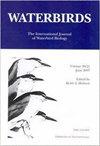Colonization and Extirpation of Great Black-Backed Gulls (Larus marinus) Nesting on Lake Ontario and the Upper St. Lawrence River
IF 0.6
4区 生物学
Q3 ORNITHOLOGY
引用次数: 1
Abstract
Abstract. Colonies of Herring (Larus argentatus) and/or Ring-billed Gulls (L. delawarensis) on Lake Ontario and the upper St. Lawrence River were searched annually, 1981–2018, for nesting Great Black-backed Gulls (L. marinus). Great Black-backed Gulls nested at nine sites where both Herring and Ring-billed Gulls nested, at seven sites with only Herring Gulls, and at one site where they nested solitarily. Nests per site ranged from 1–21 on Lake Ontario and 1–5 on the St. Lawrence River. On Lake Ontario, nest numbers increased from six nests in 1981 to 51 nests in 2001 (+ 11.3%/yr), then declined to zero nests in 2008, where they have remained ever since. The decline in nesting Great Black-backed Gulls was due primarily to mortality from Type E botulism that affected that species to a greater degree than other gull species, probably because of their superior ability to dominate and scavenge toxin-laden carrion. Temporal changes in routes and efficiency of botulinum toxin transfer likely explain why Great Black-back Gulls were initially able to colonize Lake Ontario, but have undergone extirpation in recent times. Our results illustrate how changes in disease prevalence in the Great Lakes can degrade environmental quality to the extent that some species simply cannot persist.大黑背鸥(Larus marinus)在安大略湖和上圣劳伦斯河筑巢的殖民化和灭绝
摘要1981年至2018年,每年都会在安大略湖和圣劳伦斯河上游搜寻鲱鱼(Larus argentatus)和环嘴鸥(L. delawarensis)的栖息地,寻找筑巢的大黑背鸥(L. marinus)。大黑背鸥在9个鲱鱼鸥和环嘴鸥都筑巢的地方筑巢,在7个只有鲱鱼鸥筑巢的地方筑巢,在一个它们单独筑巢的地方筑巢。每个筑巢点的巢数在安大略湖的1-21个和圣劳伦斯河的1-5个之间。在安大略湖上,鸟巢的数量从1981年的6个增加到2001年的51个(年增长率为11.3%),然后在2008年下降到0个,从那以后一直保持不变。筑巢的大黑背鸥的减少主要是由于E型肉毒杆菌中毒导致的死亡率比其他海鸥更大,可能是因为它们具有优越的统治能力和清除含毒腐肉的能力。肉毒杆菌毒素转移途径和效率的时间变化可能解释了为什么大黑背鸥最初能够在安大略湖定居,但最近却经历了灭绝。我们的研究结果说明了五大湖疾病流行的变化是如何降低环境质量的,以至于一些物种根本无法生存。
本文章由计算机程序翻译,如有差异,请以英文原文为准。
求助全文
约1分钟内获得全文
求助全文
来源期刊

Waterbirds
生物-鸟类学
CiteScore
1.30
自引率
0.00%
发文量
0
审稿时长
6-12 weeks
期刊介绍:
Waterbirds is an international scientific journal of the Waterbird Society. The journal is published four times a year (March, June, September and December) and specializes in the biology, abundance, ecology, management and conservation of all waterbird species living in marine, estuarine and freshwater habitats. Waterbirds welcomes submission of scientific articles and notes containing the results of original studies worldwide, unsolicited critical commentary and reviews of appropriate topics.
 求助内容:
求助内容: 应助结果提醒方式:
应助结果提醒方式:


